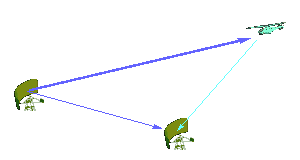Bistatic Radar Sets

Figure 1: two radar sets co-operate bistatically: the second radar receives the returns of the first one.
Generally, the transmitter and receiver share a common antenna, which is called a monostatic radar system. A bistatic radar consists of separately located (by a considerable distance) transmitting and receiving sites. Therefore, a monostatic Doppler radar can be upgraded easily with a bistatic receiver system or (by use of the same frequency) two monostatic radars are working like a bistatic radar. A bistatic radar makes use of the forward scattering of the transmitted energy.
In case of a bistatic radar set there is a larger distance between the transmitting unit and the receiving unit and usually a greater parallax. This means, a signal can also be received when the geometry of the reflecting object reflects very little or no energy (stealth technology) in the direction of the monostatic radar.
In practice it is mainly used for weather radar. The bistatic radar technology has been in use for several years at the Institute of Atmospheric Physics at the German Aerospace Center. (www.pa.op.dlr.de/poldirad/)
This system is also of some importance in militar applications. The so-called „semi-active” missile control system as used in the missile unit „HAWK” is practically a bistatic radar.
By receiving the side lobes of the transmitting radars direct beam, the receiving sites radar can be synchronized. If the main lobe is detected, an azimuth information can be calculated also. A number of specialized bistatic systems are in use, for example, where multiple receiving sites are used to correlate target position.
Remember that the helicopters rotor has a speed limit (a little bit less than sonar speed at the rotor ends), a special spectrum of Doppler frequencies gives information about the actual flight phase and the course of the helicopter.
A tactical idea in Kosovo war was possibly a transmitting station radiate the airplane outside the (technical or political) weapons range of activity and a second station could command the air defense weapon system only by passive reception. VHF-radars like P–12 or P-18 are particularly suitable for such bistatic arrangement. The disguising effect at VHF- frequencies is not only ineffective but almost unsuitable by resonance (Mie- scattering!).

Figure 2: Bistatic VHF- radars
Since additional aspect of the Stealth technology also consists in forming the shape of the airplane so, more energy is reflected sideward, than back to the transmitter, this approaches the bistatic arrangements of radar systems.
E.g. an optimal combination would be, a P-18 (with for meter waves' quite narrow antenna diagram of 6°) works quite normal from a distance of about 60 km in the transmit mode therefore, and a P–12 registers the expected trace (with 10° of an a little broader antenna diagram) with stopped antenna and turned off transmitter in a distance of about 20 km. A weapon fire-control therefore is possible without expensive computer technology. If the missile is launched, the missile-control also sends, but then it's too late for reactions.
